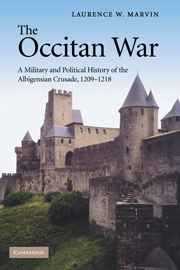Book contents
- Frontmatter
- Contents
- List of abbreviations
- List of maps and plans
- Translation of names and places; calculation of distances
- Preface and acknowledgments
- Maps and plans
- 1 Introduction
- 2 The campaign of 1209
- 3 Simon of Montfort and the campaign of 1210
- 4 The campaigns of 1211
- 5 Drawing the noose: the campaign year of 1212
- 6 The athlete of Christ triumphs: late 1212 through Muret 1213
- 7 From Muret to Casseneuil: September 1213 to December 1214
- 8 The two councils and Prince Louis's crusade, January–December 1215
- 9 The southern counter-attack begins: February 1216 to fall 1217
- 10 The second siege of Toulouse and end of the chief crusader: 1217–1218
- Aftermath and epilogue
- Select bibliography
- Index
3 - Simon of Montfort and the campaign of 1210
Published online by Cambridge University Press: 18 July 2009
- Frontmatter
- Contents
- List of abbreviations
- List of maps and plans
- Translation of names and places; calculation of distances
- Preface and acknowledgments
- Maps and plans
- 1 Introduction
- 2 The campaign of 1209
- 3 Simon of Montfort and the campaign of 1210
- 4 The campaigns of 1211
- 5 Drawing the noose: the campaign year of 1212
- 6 The athlete of Christ triumphs: late 1212 through Muret 1213
- 7 From Muret to Casseneuil: September 1213 to December 1214
- 8 The two councils and Prince Louis's crusade, January–December 1215
- 9 The southern counter-attack begins: February 1216 to fall 1217
- 10 The second siege of Toulouse and end of the chief crusader: 1217–1218
- Aftermath and epilogue
- Select bibliography
- Index
Summary
The year 1210 began in uncertainty, but conditions for the crusade would rapidly improve when the weather warmed and reinforcements arrived. It was in this year that one of the most important and infamous aspects of the Albigensian Crusade became institutionalized by the papal legates: the forty-day service (quarantine) required to win the indulgence. Montfort's ability to fight in geographically hostile country amidst his enemies was tested by this requirement. Besides undergoing repeated military and logistical tribulations, he had to worry about diplomatic efforts by the Count of Toulouse, the people of Toulouse, and the King of Aragon possibly undercutting his position.
Though Raimon VI had taken the cross and served with the crusade through the capitulation of Carcassonne, as mentioned previously he intended to seek out support and protection from the crusade by going directly to the sources of power, in this case his primary feudal overlord, Philip Augustus, and his spiritual overlord, Pope Innocent. When Montfort's military fortunes began to sour during the autumn of 1209 the Count of Toulouse traveled north to visit the King of France. While Philip treated him graciously, he refused to assist him in his attempt to reinstate tolls he had previously imposed in his territories. Next the count traveled to Rome via parts of eastern France. On his journey to the pope Raimon VI visited two of the most prominent crusaders from the previous campaign season, Odo, Duke of Burgundy, and Hervé, Count of Nevers.
- Type
- Chapter
- Information
- The Occitan WarA Military and Political History of the Albigensian Crusade, 1209–1218, pp. 69 - 93Publisher: Cambridge University PressPrint publication year: 2008



